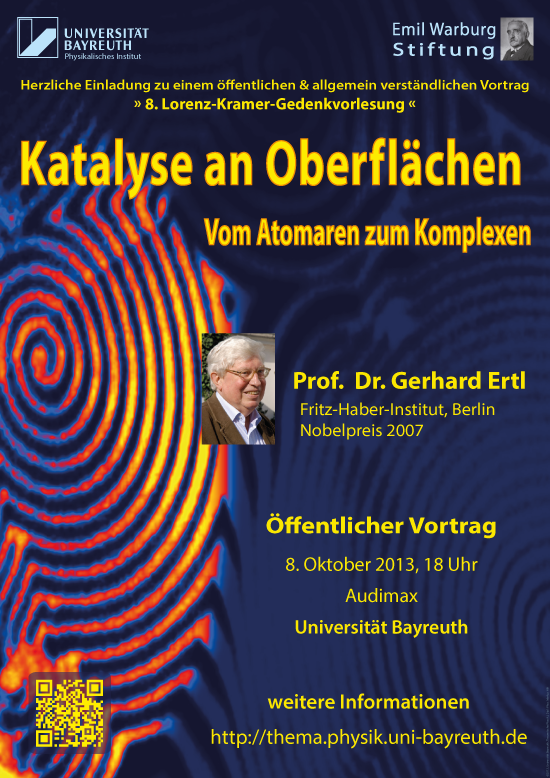2013
8th Lorenz Kramer Memorial Lecture:
Katalyse an Oberflächen: Vom Atomaren zum Komplexen
(Catalysis on surfaces: From the atomic to the complex)
Prof. Dr. Gerhard Ertl
(Fritz Haber Institute, Berlin, Germany)
October 8, 2013
Abstract:
Das diesjährige Herbstseminar über nichtlineare Physik der Universität Bayreuth steht unter dem Thema „Musterbildung in der Natur und bei Materialien“, ein Phänomen, das in offenen Systemen fernab vom thermischen Gleichgewicht auftreten kann, wie dies u.a. bei der heterogenen Katalyse der Fall ist. Dabei wird durch Wechselwirkung von Molekülen mit einer Oberfläche (Adsorption) die Reaktionsgeschwindigkeit zur Bildung eines neuen Stoffs erhöht. Am Beispiel der im Autoabgas-Katalysators ablaufenden Oxidation von Kohlenmonoxid wird zunächst erläutert werden, wie der Reaktionsablauf auf atomarer Ebene verfolgt werden kann. Unter bestimmten Bedingungen kann es dabei zu zeitlichen Oszillationen und Musterbildung der Verteilung der adsorbierten Teilchen auf mesoskopischer Skala kommen. Diese Effekte können theoretisch analysiert werden und dienen als Modelle für ähnliche Erscheinungen in anderen Bereichen der Natur.
Gerhard Ertl
Translation:
This year's fall seminar on nonlinear physics at the University of Bayreuth is on the topic of "Pattern formation in nature and materials", a phenomenon that can occur in open systems far from thermal equilibrium, as is the case in heterogeneous catalysis, among other things. Here, the interaction of molecules with a surface (adsorption) increases the reaction rate to form a new substance. Using the oxidation of carbon monoxide in a car exhaust catalyst as an example, we will first explain how the reaction process can be followed at the atomic level. Under certain conditions, temporal oscillations and pattern formation of the distribution of adsorbed particles on a mesoscopic scale can occur. These effects can be analysed theoretically and serve as models for similar phenomena in other areas of nature.

